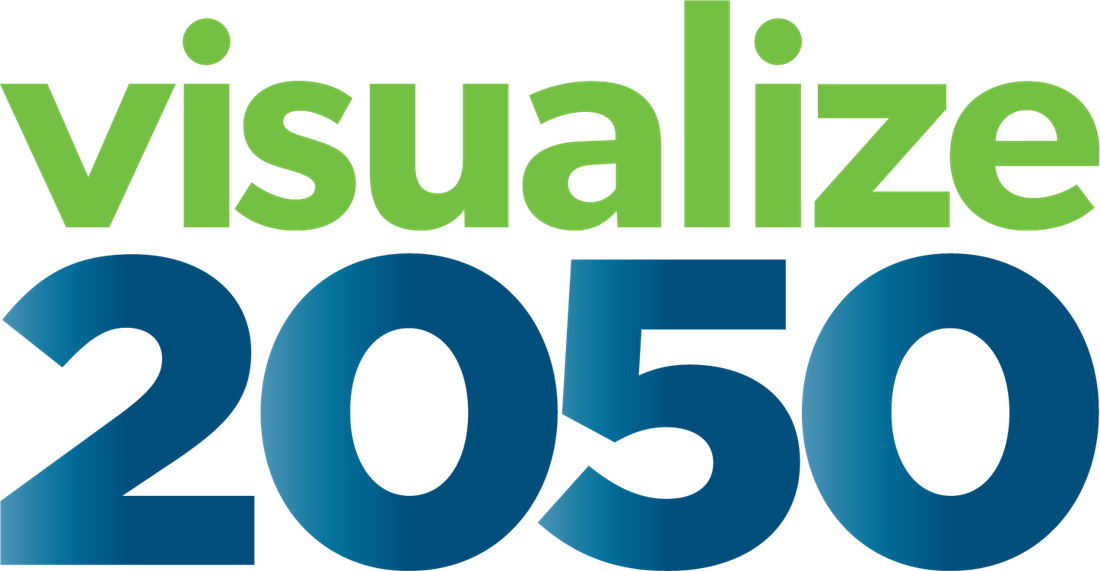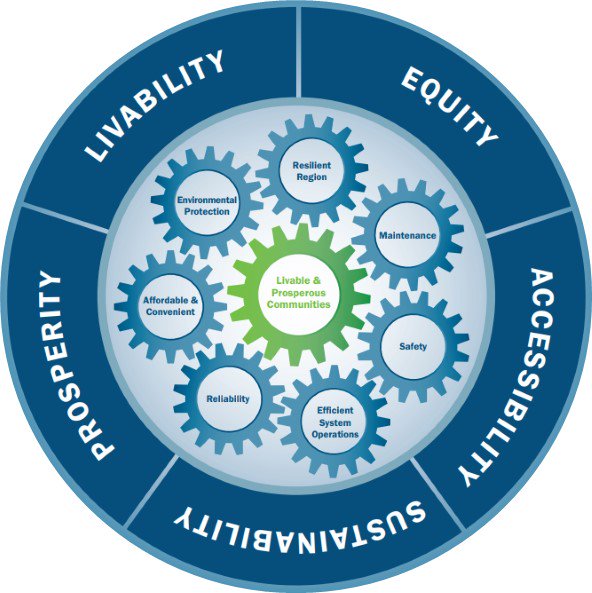
On February 15, the TPB approved the launch of Visualize 2050, which updates the current approved plan, Visualize 2045. The update gets underway with the Visualize 2050 Technical Inputs Solicitation and inputs to the Fiscal Year 2025 – 2028 Transportation Improvement Program (TIP).
As part of the Technical Inputs Solicitation, the public is welcome to comment on the current long-range plan projects and offer feedback on whether projects should remain in the plan or be altered. The current list of plan projects for the District of Columbia, Maryland, and Virginia, along with a feedback form, are available online. Visit the Visualize 2050 Get Involved page to learn more and complete the feedback form.
What are the initial steps in the plan update?
Spring 2023 actions center around the Technical Inputs Solicitation, which focuses on the plan’s Constrained Element and the air quality conformity project inputs. Information on the solicitation is available on the Visualize 2050 webpage. Key steps in this process include:
TPB Staff Roles
- Prepare preliminary project lists from the current plan organized into two groups to get the conversation started: “funded/committed” projects (under construction or have received funding) or “developmental stage” projects.
- Forward public input on the projects to TPB member jurisdictions.
- Coordinate meetings with board members and their technical agency staff to discuss potential projects and project updates.
TPB Member Roles
- Re-examine all projects, programs, and policies in the current plan and TIP and resubmit projects for the new plan after evaluating whether projects are consistent with the TPB’s regional planning priorities.
- Update financial forecasts for the planning horizon.
- Propose new projects and project costs.
June 30 is the deadline for TPB members to complete submission of project conformity inputs for the Visualize 2050 update. Once TPB staff receives the projects, staff will review and coordinate for next steps.
Why is the Technical Inputs Solicitation important?
The Technical Inputs Solicitation is important because it communicates what types of projects, programs and policies are federally required to be included for the update of the region’s long-range transportation plan. The solicitation also communicates the types of projects that the region would like to see planned and funded in the future, to help achieve our shared regional goals of:
- Safety
- Maintenance
- Reliability
- Affordable and Convenient
- Efficient Systems Operations
- Environmental Protection
- Resiliency
- Building Livable and Prosperous Communities
How will Visualize 2050 satisfy federal requirements?
Federal regulations require an update to the long-range transportation plan every four years, with the last update to Visualize 2045 approved by the TPB in June 2022.
Visualize 2050 will be undertaken in two years rather than four to provide an opportunity for board members to revisit the plan’s projects, programs, and policies to see if changes should be made to align the plan with TPB’s policy priorities and findings from various TPB scenario studies, performance analysis, and other TPB focus areas.
The federal government requires that the TPB, as the region’s Metropolitan Planning Organization (MPO), ensures its long-range transportation plan demonstrates both the financial viability of projects and conformity with federal air quality standards.
TPB gathers all the inputs (projects, programs, and policies) necessary for TPB staff to test for fiscal constraint and air quality conformity—two federal requirements designed to ensure that the region’s long-range transportation plans are financially feasible and that they support long-term air quality improvement goals.
What is meant by fiscal constraint and air quality conformity?
Fiscal/Financial Constraint
Financial constraint means that each project must be capable of being completed using revenue sources that are already committed, available, or reasonably expected to be available in the future.
TPB’s member agencies are responsible to maintain, operate and expand the transportation infrastructure and services. Agencies are also required to identify the operations and maintenance programs that are needed to keep the planned transportation system in a state of good repair. This includes major rehabilitation or replacement of aging roadways, bridges, railcars, transit stations and stops, and other infrastructure as it nears the end of its useful lifespan. Expansion programs generally entail adding roadway, trail, and/or transit capacity and at times reducing capacity by changing current infrastructure or service.
An estimate of the total costs for such operations, maintenance and expansions programs is required to be included in Visualize 2050. Funding for day-to-day operations and maintenance activities, like repaving roadways, inspecting, and maintaining transit vehicles, installing safety-related infrastructure, and paying train and bus operators, must also be identified.
Air Quality
Air Quality Conformity refers to whether the financially constrained element of the long-range transportation plan projects collectively contribute to the air quality improvement goals embodied in the Clean Air Act Amendments of 1990. If the LRTP is found by the TPB to meet regional air quality goals, federal agencies certify that the plan is “in conformity.”
Projects that add or remove roadway or transit capacity could affect air quality. These include system expansion projects like new or widened roadways, new transit lines or bus only lanes, or expanded transit service on existing lines. Because of that effect, they are required to be in Visualize 2050 and part of the air quality conformity test.
Another key required input is transit service and fare assumptions—the policies that will affect the operation of the transportation system and could therefore affect travel patterns and air quality. This includes new or updated route, frequency, and fare policy information for the region’s rail and bus systems, as well as new or updated lane restrictions and hours of operation for HOV and HOT facilities.
How do long-range projects further regional priorities?
Projects, programs, and policies in the Visualize 2050 plan update should:
- Reflect the TPB’s priorities, uphold the TPB’s principles, advance one or more TPB goals, and implement one or more of the TPB’s priority strategies, as documented in the TPB Synthesized Policy Framework.
- Consider and apply other insights gained through public opinion research and public comment, performance, and air quality analysis, and more.
In 2022, the TPB emphasized its principles, goals, strategies, and performance measures in the TPB’s Synthesized Policy Framework. At its core, the Policy Framework explains the region’s values, what the TPB as an MPO aims to accomplish, how its goals will be accomplished, and how the TPB will determine the impact of its planned strategies.
As TPB member jurisdictions review and resubmit projects for the Visualize 2050 long-range plan update, their staff will compare projects to TPB’s principles and goals to ensure that projects further regional priorities illustrated in the graphic below.

What happens next with the inputs?
The public is welcome to comment on the long-range plan projects. The current list of plan projects for the District of Columbia, Maryland, and Virginia, along with a feedback form, are available online. Visit the Visualize 2050 Get Involved page to learn more.
The deadline for TPB member agencies to submit their inputs for the long-range plan and Air Quality Conformity Analysis is June 30, 2023.
Follow the progress of Visualize 2050 through one or more of the following: (1) Visit visualize2050.org, (2) Check this COG website for periodic updates, (3) Follow @NatCapRegTPB on Twitter and Facebook, and 4) Subscribe to the TPB News monthly e-newsletter.